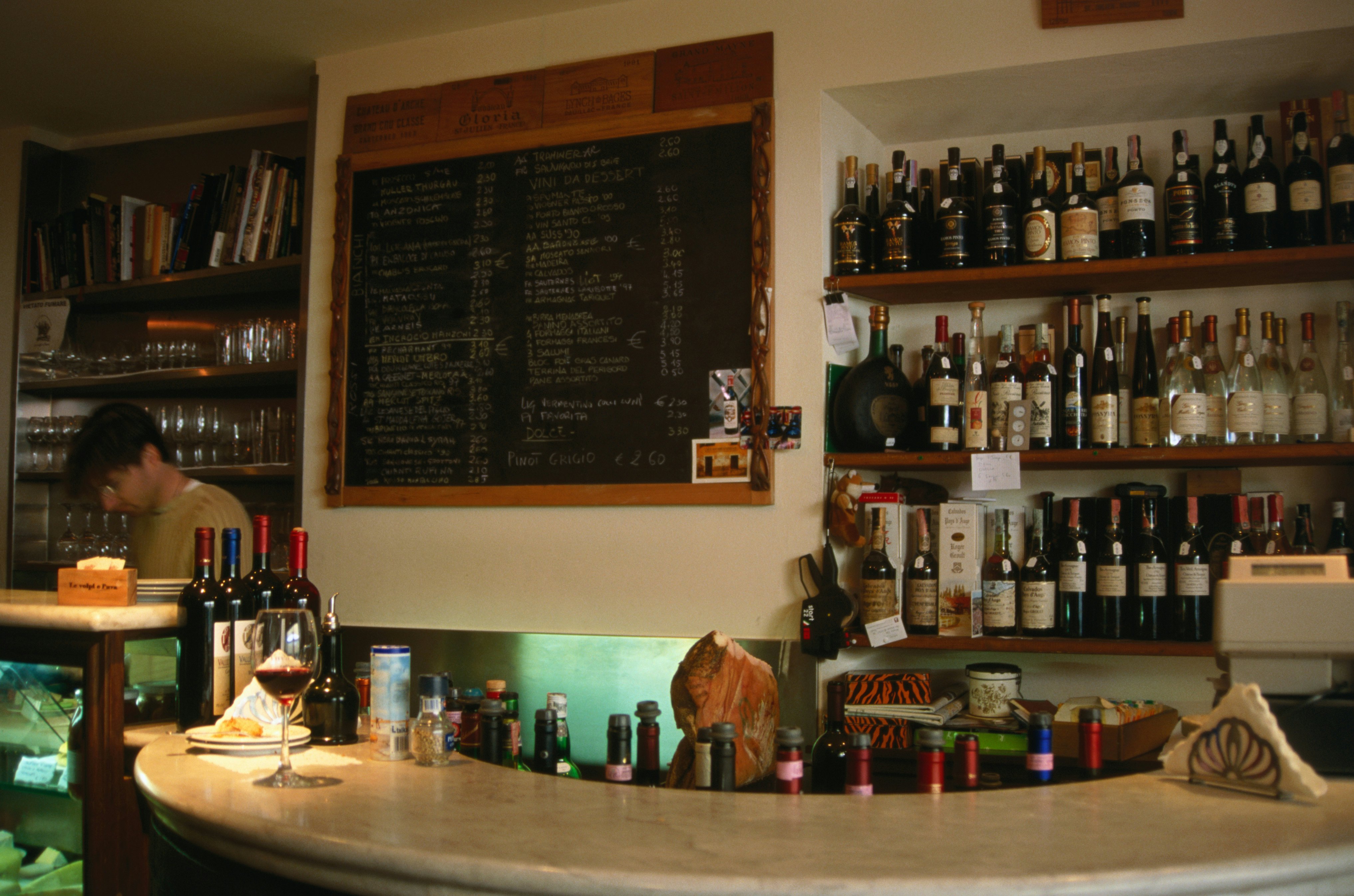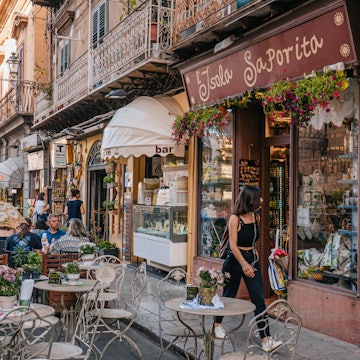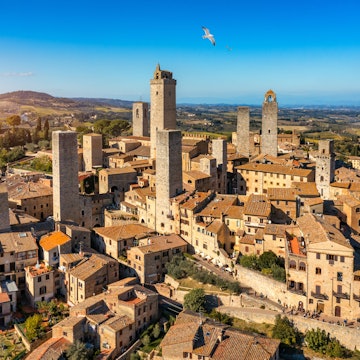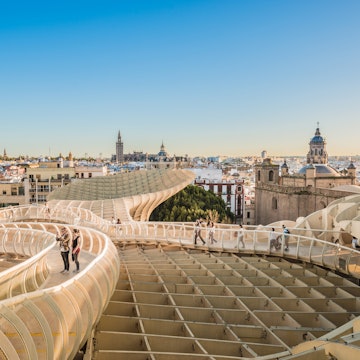

A panoramic view of Florence from Piazzale Michelangelo. ArTono/Shutterstock
Sitting comfortably along the banks of the Arno River, Florence has been welcoming tourists since the early days of international tourism, building a global reputation that is hard to match.
British and German aristocrats began traveling to the city to admire Gothic and Renaissance masterpieces as early as the 17th century, and while the era of the Grand Tour is long gone the stream of visitors never stopped.
As far as Italian cities go, Florence is at the expensive end of the spectrum. The UNESCO-listed city center measures only about 5 sq km (1.9 sq miles), but draws in millions of people each year. The flow of tourism has been driving up prices for decades, with budget accommodations becoming increasingly hard to find. To this, add dozens of world-class museums and day-trip opportunities, and the cost of a visit to the Renaissance city could make your eyes water. Luckily, all is not lost.
The option to splurge is always available, but if you’d rather save some money to extend your stay or continue your Italian itinerary, here are some tips to help you cut costs when in Florence.

Look for low-season deals
As for many other popular cities, the time of the year you choose to visit Florence can make a huge difference in terms of costs. Tourist crowds start clogging up the narrow streets of inner Florence in spring, and this typically lasts until early autumn. Human traffic reaches its peak in the summer, when Italians take their holidays and contribute to the queues.
From May to September accommodation prices can rise dramatically in the historic city. If you are planning to visit during this period, it’s best to book months in advance to be sure to find the cheapest options available.
If you are flexible and don’t mind the uncertain weather, visiting between November and February (excluding the two weeks from Christmas to the Epiphany), guarantees some good deals. Besides the offers on hotels and apartments, many major museums offer low-season rates which are made even more attractive by the absence of crowds. Access to the Uffizi, for instance, costs €12 (US$14) instead of €25 (US$29). Tickets for Palazzo Pitti and the Boboli Gardens cost €10 and €6 (US$11 and US$7) respectively, instead of €16 and €10 (US$18.79 and US$11.74).
Check flights to Pisa
Florence’s Amerigo Vespucci airport is conveniently connected to the city center thanks to the T2 tram line that links the terminal to the Santa Maria Novella railway station. Yet, it may be cheaper to fly into Tuscany’s other airport in Pisa. Located a little over an hour’s drive from Florence, Pisa’s Galileo Galilei airport offers many more options for low-cost flights. Ryanair, Wizz Air, Vueling and easyJet all fly in and out of Pisa daily.
When booking your flights consider that you’ll need to add about €30 (US$35) to get from Pisa to Florence and back. From Pisa’s airport, you can reach the Pisa Centrale railway station in about five minutes with the Pisamover service (€6.50/US$7.63) and then get to Florence’s city center with a regional train in one hour (€9.30/US$10.92).
Look out for fixed-price lunch menus …
Florence's city center has no shortage of restaurants, but only some trattorie offer an all-included, fixed-price menu. Such menus typically include a first and second course, plus a contorno (side dish) for prices ranging from €14 to €20 (US$16.44 to US$23).
When walking through the side streets of the city center, look out for signs promoting lunch deals. While increasingly rare, they are still available at old-school and often unassuming restaurants such as Trattoria Guelfa, Ostaria dei Centopoveri, Il Contadino and Trattoria Da Giorgio.

… or try some great street food
If you’d rather eat something on the go, stop by any bakery to try one of Florence’s traditional sandwiches for around €7 (US$8.22). Schiacciata bread is similar to focaccia, having a crispy outer crust and a soft interior typically stuffed with anything from cured meats to grilled vegetables and cheeses. All’Antico Vinaio has turned this simple meal into viral social media content, as the permanent queue extending from its doors in Via dei Neri testifies. But sandwich shops are scattered all around the city. Try Pugi, Forno Becagli, Schiacciamatta (open until late) or Schiaccia Passera.
Stuffed schiacciata is not the only sandwich Florence is known for. Audacious travelers may want give lampredotto a try – this famous Florentine street food is made with the fourth and final stomach of a cow, called the abomasum, which is slow-cooked in a broth and covered in salsa verde (green sauce made with parsley and anchovies) before being served between soft white bread. Try it at Tripperia Pollini or 'l Trippaio di San Frediano.
Use regional trains for your day trips
If you are planning to spend more than a few days in Florence, it’s worth venturing out of the city to explore the fascinating towns that dot Tuscany. To do so, take the train. Inexpensive regional Trenitalia trains connect Florence with Lucca, Pisa, Siena, Arezzo, Pistoia, Prato and many other destinations, often for under €10 (US$11.74) each way.
There is no need to book in advance. Unlike high-speed trains, tickets for regional trains can be purchased on the spot without a price increase, allowing for spontaneous day trips within and beyond Tuscany's borders.

Check out the official guided tours of Florence’s museums
Hiring a private guide to tour the city will typically cost you between €60 and €120 (US$70 and US$141) per hour. Many cultural institutions, however, provide their own official guides for a small fee added to the ticket price. It’s well worth booking your spot in one of these official guided tours – besides offering the explanation of a specialist, they often allow you to enter areas that are not accessible independently.
For instance, the 18th-century anatomical waxes of the recently refurbished La Specola Natural History Museum can only be visited with a guide, which costs €3 (US$3.52) per person on top of the ticket. A guided tour of Palazzo Medici Riccardi, the Medici’s first Florentine residence housing the spectacular Cappella dei Magi frescoed by Benozzo Gozzoli, costs €4 (US$4.69).
Check out the many group activities organized by MUS.E, the foundation handling the tours of Florence’s civic museums. With €5 (US$5.87) you can book a visit to Palazzo Vecchio’s secret passages, which will take you to Francesco I’s Studiolo – a Renaissance wonder room – through the hidden staircases of Florence’s city hall.
Drink your espresso al banco
If you decide to have your coffee at the table, you may be charged a service fee. The rule doesn’t apply to all cafes, but to play it safe, do as Italians do and have your espresso al banco (at the counter). In Italy, coffee breaks are quick and frequent. People drink their shots of caffeine standing up, taking only a few moments before continuing on their day.

Get your wine at local enoteche
Wine has been a Tuscan staple since the Middle Ages and continues to be so today. When buying wine, visit enoteche (wine shops) selling locally produced varieties such as Chianti or Sangiovese obtained from the hills surrounding the city. In shops such as Alla Sosta dei Papi or Vino Divino, you can bring your own bottle and have it filled with young wine for just a few euros. Fratelli Zanobini and Casa del Vino, both in the San Lorenzo neighborhood, are good places to stop for a glass or two between sights.
Drinking on the street is allowed in Italy and it’s common for Florentines to gather in public squares during warm summer evenings and enjoy a bottle of wine. When ordering wine in restaurants the cheapest option will always be vino della casa (house wine), often sold by the carafe rather than the bottle.
Buy a Firenze Card for discounted access to museums
Art enthusiasts have so many museums to choose from that a single trip to Florence will inevitably feel too short, no matter the length of the stay. If you do decide to squeeze in as many cultural sights as you can, it’s worth checking out the Firenze Card. Costing €85 (US$100) and valid for 72 hours (with an extension option available), this card includes access to over 70 museums, galleries, churches and monuments.
A guide to daily costs in Florence
Hostel room: €35–55 (US$41–65)
Basic room for two: €80–120 (US$94–141)
Self-catering apartment (including Airbnb): €80–120 (US$94–141)
Espresso coffee: €1.20 (US$1.40)
Pizza: €8–14 (US$9.39–16.44)
Dinner for two in a trattoria: €60 (US$70)
Beer at the bar: €6 (US$7)
Schiacciata sandwich: €7 (US$8.22)
Museum tickets: €10–25 (US$11.74–US$29)
Glass of wine: €3–9 (US$3.52–10.57)
Tram ride: €1.70 (US$1.99)
Average daily costs: €130–200 (US$153–235)
















